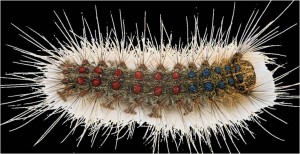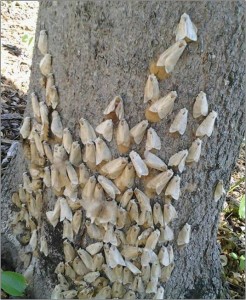BOSTON – Following widespread defoliation by the invasive gypsy moth in 2016, state environmental officials are predicting another season of higher than usual caterpillar feeding in 2017 and are encouraging home owners to survey trees on their property to identify egg masses due to the absence of leaves, and to begin the scheduling of the treatment process with a certified arborist or licensed pesticide applicator. Egg mass surveys performed by foresters throughout the state indicate the likelihood of a higher than normal gypsy moth caterpillar hatch this spring.
Gypsy moth populations in Massachusetts have generally experienced cyclical patterns, but have been controlled by natural factors, including weather, natural and introduced enemies, and the resilience of Massachusetts forests to withstand defoliation. Recent drought conditions have limited the effectiveness of a soil borne fungus, Entomophaga maimaiga, which has helped keep gypsy moth populations in check since the last large outbreak during the 1980’s. Though trees are able to overcome a single defoliation event, successive years of severe insect feeding, or the addition of other stressors such as drought, can lead to long-term tree damage or tree mortality.
“The Department of Conservation and Recreation remains steadfast to combating invasive species like the gypsy moth to ensure the Commonwealth’s natural resources are protected for all to enjoy,” said DCR Commissioner Leo Roy. “The agency will continue to monitor the situation; however, by sounding the alarm early, we hope to provide the public with ample opportunity to treat their own trees before it is too late.”
“The Department of Agricultural Resources remains committed to assist our sister agencies and the public combat the gypsy moth problem,” said MDAR Commissioner John Lebeaux. “It is important the public look at all options when attempting to control gypsy moths. If hiring a company to help with the issue please contract with a well-trained, licensed applicator. We hope that early detection and education will lead to the most effective and environmentally appropriate response to this problem.”
In areas that have seen repeated defoliation by gypsy moth, forest health specialists recommend targeted treatments utilizing a biological pesticide such as Btk (Bacillus thuringiensis var. kurstaki) to reduce gypsy moth populations to more manageable levels. Trees should be checked beginning in the first week of May for signs that the egg masses have hatched; look for tiny, black, hairy caterpillars, only 3-5mm long, traveling from the pink egg masses in search of food, or congregating on the undersides of the leaves of oaks and other trees. Individuals interested in pursuing treatments should hire a certified arborist or licensed pesticide applicator to protect their trees in a safe and effective manner. Attached is a Gypsy Moth fact sheet highlighting the history, life cycle, and impacts on trees and forests of this invasive pest, along with recommended management strategies. For further information, please visit the DCR’s and the MDAR’s websites.
Background
The gypsy moth has been a costly and persis-tent problem in Massachusetts since its intro-duction in 1869. Despite control efforts by federal and state agencies, gypsy moth popula-tions continue to defoliate our forests here in Massachusetts and expand their range in the U.S.
Life Cycle and Identification
Gypsy moths have one generation per year. During their lifecycle they complete four dis-tinct life stages: egg, larvae (caterpillar), pu-pae, and adult (moth).
Egg: Female adult moths lay egg masses by early August on trees, houses, outdoor furni-ture, or cars where they will overwinter. Egg masses are buff colored, approximately 1-1.5 inches long ,and contain 100-1000 eggs.
Larvae: Small, mostly black caterpillars (~1/16 in long) will emerge in early May: exact timing depends upon climate conditions (~145-200 GDD). It is at this small size that the gypsy moth disperse by wind, until they land on a host tree where they begin to feed on foliage. Caterpillars will continue to feed and progress through 5-6 instars until they reach a final size up to 2.5 inches. Larger caterpillars can be identi-fied by their hairy bodies and five pairs of blue dots and six pairs of red dots down their back.
Pupae: Around the third week of June, cater-pillars will find a safe, protected location to pupate. Pupae are red-dish brown and 0.75- 1 in. long. Pupation takes 10-15 days to complete.
Adult: Adult moths will emerge in mid-July. Female moths are larger (2-2.5 in.), white with brown chevron markings, and flightless. Male moths are smaller (1.5 in.) and light brown with dark brown chevron markings. Males will fly to females to mate and complete their lifecycle.
Gypsy Moth Impacts
Damage to trees and forests by gypsy moths primarily occurs through defoliation by the caterpillar life stage. Dense feeding popula-tions can consume all the leaves on a tree, de-foliating entire stands. The preferred host tree species are deciduous oaks, maple, birch, pop-lar, willow, apple, and hawthorn. Other, less preferred deciduous trees and even conifers, like white pine or eastern hemlock, will be at-tacked by gypsy moths when there are large outbreaks. Typically, a healthy deciduous tree can survive one complete defoliation event, because they have enough energy reserved to produce new foliage in the same growing sea-son. However, multiple years of defoliation or additional stress can cause deciduous tree mortality. Conifers will die after only one heavy defoliation event.
Population Dynamics
Across Massachusetts, gypsy moth density can fluctuate greatly from year to year. Gypsy moths have cyclical peri-ods of small persistent populations and large outbreaks. Population trends are primarily driven by climate condi-tions and the balance of natural predators and disease. Predation from small mammals, birds, and insects, as well as, parasitic infection from flies and wasps regulates small populations.
Under certain conditions, gypsy moths can be significantly impacted by disease. Nucleo-polyhedrosis virus (NPV) is a wilt disease that causes high mortality in caterpillars and pupa when populations have been maintained high density in an area. The introduced fungus Ento-mophaga maimaiga (EM) causes high mortality in during both periods of low and high density infestations, but requires specific moisture and temperature conditions to effectively spread and infect the caterpillars. EM has kept gypsy moth populations from reach-ing large outbreak stages since the late 1980’s. However, dry conditions in Massachusetts can lead to large outbreaks due to lack of EM fungal success.
Management Strategies
There are several steps Massachusetts residents can take to protect their trees from mortality caused by gypsy moths. The first step in gypsy moth management is assessing and monitoring the population. Be aware of the caterpillars seen feeding in the spring, the presence and location of adult moths, and the abundance of egg masses.
The recommended insecticide treatment for gypsy moth is Bacillus thuringiensis spp. kurstaki (Btk) or another biological pesticides.
Applications should be done by licensed applica-tors with the specialized equipment required to completely coat a tree’s leaves. Btk should be applied directly to foliage soon after caterpillar emergence where it will be consumed during feeding. Btk is most effective in young caterpil-lars and will not be effective on large caterpil-lars. Treatments should typically be applied at 90-400 GDD. Often, by the time caterpillar feed-ing is noticeable on a tree, it is too late to treat. This is why it is important to check for egg masses before emergence and look for the small caterpillars in early May.
Many commonly recommended treatment op-tions are not effective in decreasing gypsy moth population or minimizing damage to trees. These include burlap strips, duct tape bands, or moth traps.
If trees have been defoliated by gypsy moth, as-sess and monitor tree health and recovery. Trees may require additional watering, fertilizing, or mulching to promote refoliation. Avoid ad-ditional stressors, such as, mechanical or chemical damage or soil compaction.
Finally, an important effort in management is to minimize gypsy moth spread. Egg masses can be located on more than just trees; common locations in-clude cars, trucks, storage and moving contain-ers. Anytime after eggs are laid in August, check for hidden egg masses to avoid spreading gypsy moths. Viable egg masses will be firm to the touch and have no holes.



